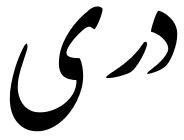Language/Dari/Grammar/Definite-and-Indefinite-Articles
| ◀️ Noun Gender and Plurals — Previous Lesson | Next Lesson — Family Members ▶️ |
Introduction: Welcome to the lesson on "Definite and Indefinite Articles" in Dari grammar. In this lesson, we will explore the usage and role of definite and indefinite articles in sentence construction. Articles play a crucial role in determining the specificity or generality of a noun, and understanding their usage is essential for effective communication in Dari. By the end of this lesson, you will be able to confidently use definite and indefinite articles in your Dari sentences. So let's dive in!
Definite Articles[edit | edit source]
Definite articles are used to refer to specific nouns that are already known or have been previously mentioned in the context. In Dari, the definite article is "ی" (pronounced as "y"). Let's look at some examples to understand its usage:
| Dari | Pronunciation | English Translation |
|---|---|---|
| میوه | mewa | fruit |
| میوهی خوب | mewa-ye khub | the good fruit |
| کتاب | ketab | book |
| کتابِ قدیمی | ketab-e qadimi | the old book |
As you can see in the examples above, the definite article "ی" is added to the noun to indicate that we are referring to a specific fruit or book. It helps in specifying the noun and distinguishing it from other similar nouns.
Indefinite Articles[edit | edit source]
Indefinite articles are used to refer to non-specific or generic nouns. In Dari, the indefinite article is "یک" (pronounced as "yek"). Let's see how it is used in sentences:
| Dari | Pronunciation | English Translation |
|---|---|---|
| میوهای | mewa-yi | a fruit |
| کتابی | ketabi | a book |
In the examples above, the indefinite article "یک" is added before the noun to indicate that we are referring to any fruit or any book in a non-specific manner. It does not specify a particular fruit or book, but rather represents the noun generally.
Exceptions and Variations[edit | edit source]
While the definite article "ی" and the indefinite article "یک" are the most commonly used articles in Dari, there are some exceptions and variations in their usage. Let's explore them:
Omission of Definite Article[edit | edit source]
In some cases, the definite article "ی" can be omitted when the noun is preceded by certain possessive pronouns or demonstrative pronouns. Let's look at an example:
| Dari | Pronunciation | English Translation |
|---|---|---|
| پسرِ من | pesar-e man | my son |
| کتابِ او | ketab-e u | his/her book |
In the examples above, the definite article "ی" is not used before the noun "پسر" (son) and "کتاب" (book) because they are preceded by possessive pronouns "من" (my) and "او" (his/her).
Variation in Indefinite Article[edit | edit source]
In some cases, the indefinite article "یک" can be shortened to "ی" before certain consonants. Let's see an example:
| Dari | Pronunciation | English Translation |
|---|---|---|
| ی کتاب | y ketab | a book |
| ی میوه | y mewa | a fruit |
In the examples above, the indefinite article "یک" is shortened to "ی" before the nouns starting with the consonants "ک" (ketab) and "م" (mewa).
Cultural Insight[edit | edit source]
In Dari-speaking cultures, the usage of definite and indefinite articles is influenced by regional variations and historical factors. For example, in some regions, the definite article "ی" is pronounced as "ه" (pronounced as "ha"), which reflects the influence of local dialects and accents. Additionally, the choice of using definite or indefinite articles can convey subtle cultural nuances and perspectives. For instance, using the definite article "ی" before a noun can indicate a higher level of specificity and importance given to that particular noun in the sentence. Understanding these cultural variations can enhance your understanding and usage of definite and indefinite articles in Dari.
Practice Exercises[edit | edit source]
Now that we have learned about definite and indefinite articles in Dari, let's practice using them in sentences. Complete the following exercises by choosing the appropriate article for each noun:
Exercise 1: Choose the appropriate article (definite or indefinite) for each noun: 1. ماشین (car) 2. مرغ (chicken) 3. کتاب (book) 4. میوه (fruit)
Exercise 2: Fill in the blanks with the correct form of the definite or indefinite article: 1. من دارم ____ جدید. (book) 2. او یک ____ خوب دارد. (car) 3. آنها دارند ____ قدیمی. (book) 4. من خریدم ____ خوب. (fruit)
Solutions: Exercise 1: 1. یک 2. یک 3. یک 4. ی
Exercise 2: 1. کتابِ 2. ماشینِ 3. کتابِ 4. میوه
Conclusion[edit | edit source]
Congratulations! You have successfully learned about definite and indefinite articles in Dari. You now understand how to use these articles to specify or generalize nouns in sentences. Remember to practice using them in your conversations and writing to further reinforce your understanding. In the next lesson, we will explore another important aspect of Dari grammar. Till then, keep up the excellent work!
Sources[edit | edit source]
Other Lessons[edit | edit source]
- Asking Questions
- Personal Pronouns
- Nouns
- How to Use Have
- Comparatives and Superlatives
- Questions
- How to Use Be
- Give your Opinion
- Basic Prepositions
- Adverbs
| ◀️ Noun Gender and Plurals — Previous Lesson | Next Lesson — Family Members ▶️ |

